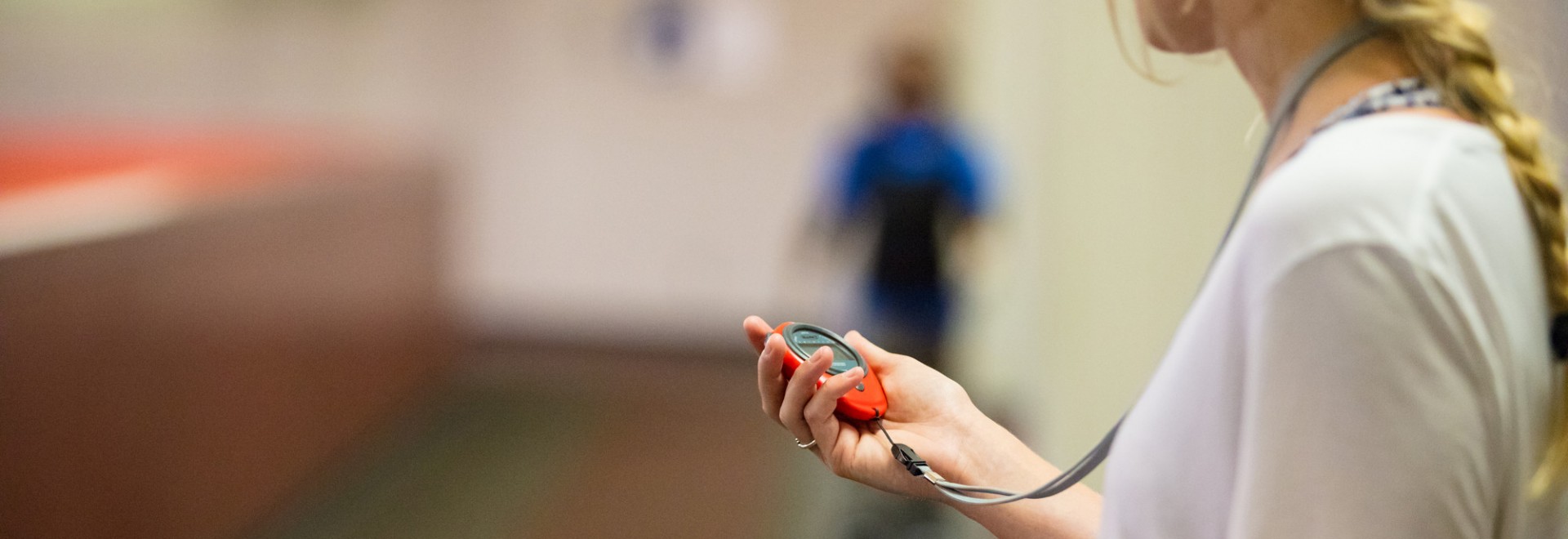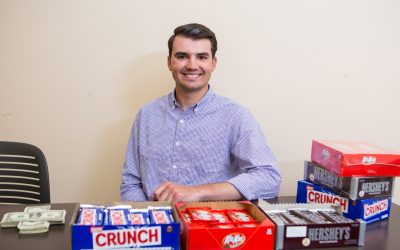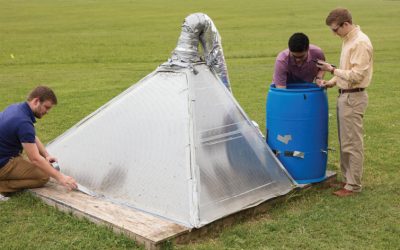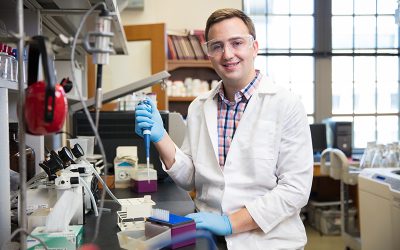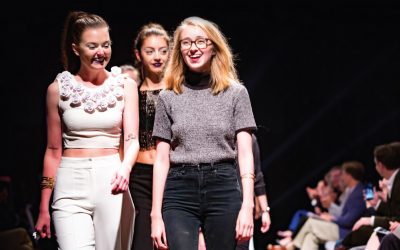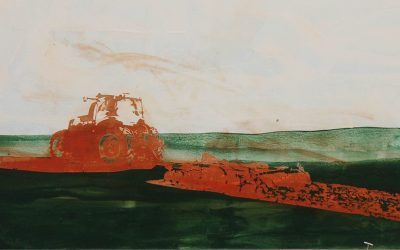Allen straps on a knee brace, designed to mimic the effects of arthritis on the joints; she hopes that her research will lead to a greater awareness of ageist attitudes.
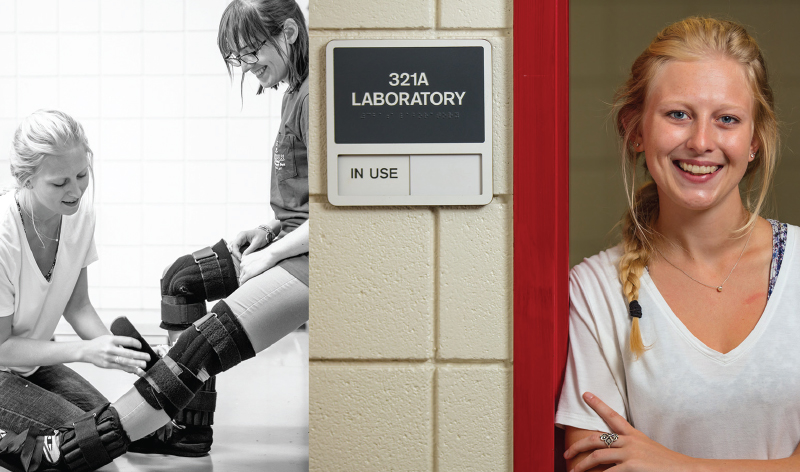
Growing Up and Growing Old: Developing Research Skills in the Aging Lab
by Samantha Kirby
“What?” I asked. “What?” My hearing was poor. I turned toward the speaker, but goggles occluded my vision. I had to move slowly to keep my balance. I felt so old, so tired, so … impeded. But I’m only 27; how had I Rip-Van-Winkled so fast? I hadn’t met any ghosts in the woods – instead, senior kinesiology major Kelly Allen had me fastened into a Gerontologic Test suit comprised of cataract goggles, noise-canceling headphones, orthopedic shoes, a 20-pound vest, ankle weights to affect balance, a neck brace to affect posture and joint braces designed to mimic arthritis. Known as GERT, it’s a complex set of parts, but Kelly strapped me in and adjusted the fit with expert precision. Despite being new to academic research, she clearly felt at ease with the equipment.
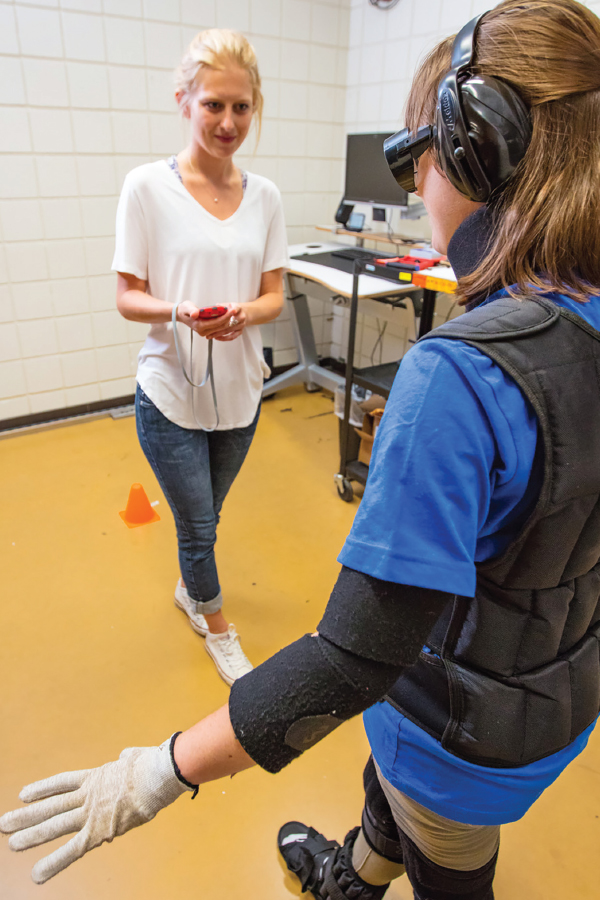
Kelly Allen pits Samantha Kirby against the timer in a senior balancing test
Once outfitted in the suit, I performed a series of senior fitness tests as Allen checked my strength, endurance, balance, and flexibility. Before and after the fitness tests, participants are asked to take a survey measuring their attitudes toward senior citizens. This “aging simulation” and survey are part of Allen’s thesis research on ageism, which explores often-implicit biases against particular age groups. Her goal is ultimately to raise awareness about ageist thinking and help young and middle-aged people develop more positive attitudes toward older adults.
The study is open to participants between the ages of 18 and 59; their attitudes are measured using an Aging Semantic Differential scale. Before donning the GERT suit, participants score an average of 70 on this scale, which ranges from 24 to 168. Preliminary results show an approximately 10 percent positive change in these reported attitudes after performing the exercises. More data is needed to come to any definitive conclusions, but Allen’s mentor, Dr. Michelle Gray, who is director of the Exercise Science Research Center, notes that “a 10 percent change is quite a bit. … I do think it is meaningful.”
Allen admitted to knowing little about ageism before beginning work on her thesis, but since then she has become well-acquainted with this particular social issue. Her research is complemented in a very tangible way by her work as a caregiver for older adults. Through her personal interactions with seniors in their homes, she has been able to integrate real-life stories about the effects of ageism into the concepts she is studying. For her this grounds the research in reality. “It has definitely given me the opportunity to read … what people have discovered in research, and then listen to stories from older adults and hear the same exact thing.”
Gray is enthusiastic about her mentee’s work. “Kelly’s amazing! I can teach her the procedures and let her have free reign.” Gray plans to use Allen’s data in assessing the efficacy of the GERT suit for future researchers.
The particular GERT suit used by the research team was designed in 2009 by German ergonomist Wolfgang Moll, and is predicted to age its wearer 30 to 40 years. To date there is scant research on its effects and uses. At first, Allen was hesitant to pursue her thesis using equipment with such a sparse experimental history. But with the help of Gray and Ph.D. candidate Ashley Binns, Allen has grown much more comfortable with her role in the research process. “I’m one of the first,” she says with a laugh, “And that’s okay.”
While seeing the effects of aging firsthand has helped Allen to appreciate her subject on a more personal level, she concedes that it has also helped her realize that research may not be her calling. She hopes instead to pursue a career such as nursing or occupational therapy that would allow her to see the immediate impact she is making in people’s lives. “Even though I’m enjoying the large scale of research,” she said, “personally what I enjoy most is interaction one-on-one.”
More Field Notes Stories
Capitalizing on Viral Videos
“There are a lot of YouTubers out there who are popular and using products spontaneously, which I believe is more powerful with Millennials.” Six students enter the Walton College Behavioral Business Research Lab, painted a soothing peach color to put them...
Pyramid Power
Garret Gardenhire, Kevin Le and Matt Annis monitor their solar-powered food dehydrator, designed to combat food insecurity in developing countries. Freshmen honors engineering students Garret Gardenhire, Kevin Le and Matt Annis inherited a simple machine and a big...
Double Duty for Future MD
As part of his biochemistry thesis, Will Pohlman developed a dye technique that may prove useful to pharmacological companies. Biochemistry and animal science proved to be the perfect double major for Sturgis Fellow Will Pohlman, who dreamed about a career...
Fashion for the 21st-Century Flower Child
“They’re incredible! Katie and Laura took a dream I had and made it happen – they’ve opening up a whole new area of research for our program.” The theme was “Futuristic Floral” and the student designers rose to the challenge: the models who strutted down the runways...
Big Picture Data
“Hannah has painted something that everyone can respond to on a personal level, that offers people a way into a place to see it differently.” Rain or shine, at 7 a.m. every Tuesday for five months honors landscape architecture major Hannah Moll showed up, camera in...
